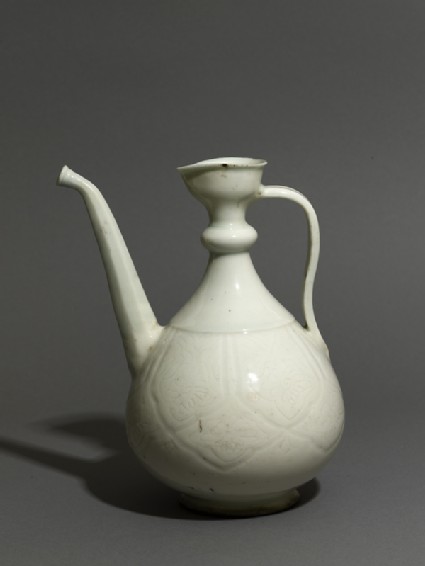Browse: 355 objects
Ewer with incised floral decoration
-
Details
- Associated place
- Date
-
2nd half of the 17th century - 18th century
Safavid Period (1501 - 1722)
- Material and technique
- fritware, with incised decoration under a transparent glaze
- Dimensions
- 21.5 x 18 x 13.5 cm max. (height x width x depth)
- Material index
- Technique index
- Object type index
- No. of items
- 1
- Credit line
- Presented by Sir Frank Brangwyn, 1950.
- Accession no.
- EAX.3035
-
Further reading
Allan, James W., Islamic Ceramics, Ashmolean-Christie's Handbooks (Oxford: Ashmolean Museum, 1991), no. 40 on p. 64, illus. p. 65
Piper, David, and Christopher White, Treasures of the Ashmolean Museum: An Illustrated Souvenir of the Collections, revised edn (Oxford: Ashmolean Museum, 1995), no. 45 on p. 47, illus. p. 47 fig. 45
Oxford: Ashmolean Museum, 24 May 2006-23 December 2008, Treasures: Antiquities, Eastern Art, Coins, and Casts: Exhibition Guide, Rune Frederiksen, ed. (Oxford: Ashmolean Museum, 2006), no. 221 on p. 79, illus. p. 79
Glossary (2)
fritware, glaze
-
fritware
Ceramic material composed of ground quartz and small quantities of clay and finely ground frit (frit is obtained by pouring molten glass into water).
-
glaze
Vitreous coating applied to the surface of a ceramic to make it impermeable or for decorative effect.
Location
Objects are sometimes moved to a different location. Our object location data is usually updated on a monthly basis. Contact the Jameel Study Centre if you are planning to visit the museum to see a particular object on display, or would like to arrange an appointment to see an object in our reserve collections.
Collection trails
Galleries
Publications online
-

Islamic Ceramics
These two objects [EAX.3035 & EA1978.1765] are of a type usually termed ‘Gombroon ware’. Gombroon was the old name for the port of Bandar Abbas. Here the Dutch East India Company had a trading-station, and from Gombroon quantities of Persian soft-paste porcelain were shipped to Europe. Although the bulk of exported ceramics were probably blue and white, the term ‘Gombroon ware’ is helpful in distinguishing this group, in which white so obviously dominates.
Both these objects illustrate a relatively plain aesthetic which is unusual in Islamic ceramics. The origin of the shape [EAX.3035] is uncertain, but the most likely explanation is that it derives from late seventeenth – early eighteenth century Famille Verte Chinese ewers, of which there are two fines examples in the Topkapi Saray in Istanbul. Such ewers were themselves probably copied from Islamic metalwork prototypes. Moulded designs on blue and white could well have provided the inspiration for the underglaze incised patterning.
The bowl [EA1978.1765] on the other hand shows more local taste. The form, with a moulded domical centre, is part of an age-old tradition of phialae, small bowls used for pouring water, known from Greek and Archaemenid examples, and still used in the Islamic world today. The piercing of the sides of the bowl is probably the Persian potter’s attempt to emulate the translucency of Chinese porcelain and may well be the source of the rice-pattern used by the Chinese potters of the eighteenth and nineteenth century. The three stems of trefoils illustrate the typical desire of the Islamic potter for colour and design, here exquisitely rendered, and carefully balanced by the groups of black dots on the rim.
© 2013 University of Oxford - Ashmolean Museum











